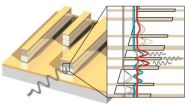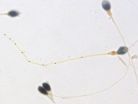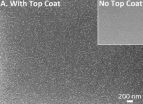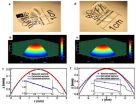(Press-News.org) Scientists at the University of Liverpool have found that the production of a protein that prevents the growth and spread of cancerous cells is impaired in patients with gastric cancer.
Cancer of the stomach is the second most common cause of death due to malignant disease worldwide. New research findings at Liverpool, however, could contribute to the development of future gastric cancer therapies by restoring the functions of a protein called, TGFβig-h3.
The protein is released by cells called myofibroblasts, which form part of the supporting tissue around cancer cells. The environment of myofibroblasts, blood vessels and other cell types, allows cancer to survive and can become as high as 70-90% of the total tumour mass.
Myofibroblasts are highly mobile cells that produce and release multiple substances that change cancer behaviour by altering their environment, leading to the growth and spread of cancerous cells. Scientists at Liverpool have now discovered that in tumours of advanced gastric cancer patients, the myofibroblasts decrease the release of a protein that would normally inhibit the growth and spread of the disease.
Professor Andrea Varro, from the University's Institute of Translational Medicine, explains "This protein normally acts as an anchor to link cells to proteins in the cancer cell environment restricting cancerous cells to the vicinity in which they have grown. This allows targeting of treatments to the area, but in advanced stages of the disease the effects of this protein are diminished, increasing the risk of the disease spreading to other parts of the body.
"We hope that this work will help develop future treatments that are based on restoring the functions of this protein, contributing to the long-term recovery of patients with this often fatal disease."
###
The research is funded by North West Cancer Research (NWCR) and the National Institutes of Health (USA). It is published in Carcinogenesis.
Notes to editors:
1. The University of Liverpool is one of the UK's leading research institutions with an annual turnover of £410 million, including £150 million for research. Liverpool is ranked in the top 1% of higher education institutions worldwide and is a member of the Russell Group. Visit www.liv.ac.uk
2. North West Cancer Research Incorporating Clatterbridge Cancer Research is made up of a merger between North West Cancer Research Fund and Clatterbridge Cancer Research and is a member of AMRC (Association of Medical Research Charities).
North West Cancer Research is a regional charity that raises money to find a better understanding of cancer. A long established charity, NWCR prides itself on only backing the very highest standard of research, ensuring the best value for all donations. Community fundraising in the North West of England and North and Mid-Wales is vital to the charity. For every £1 donated, 85p goes directly to fund cancer research in the North West with current research taking place at the Universities of Liverpool, Lancaster and Bangor.
Scientists discover how stomach cancer spreads
2012-11-13
ELSE PRESS RELEASES FROM THIS DATE:
How do cells tell time? Scientists develop single-cell imaging to watch the cell clock
2012-11-13
COLUMBUS, Ohio – A new way to visualize single-cell activity in living zebrafish embryos has allowed scientists to clarify how cells line up in the right place at the right time to receive signals about the next phase of their life.
Scientists developed the imaging tool in single living cells by fusing a protein defining the cells' cyclical behavior to a yellow fluorescent protein that allows for visualization. Zebrafish embryos are already transparent, but with this closer microscopic look at the earliest stages of life, the researchers have answered two long-standing ...
Powering lasers through heat
2012-11-13
This press release is available in German.
Since its invention 50 years ago, laser light has conquered our daily life. Lasers of varying wave lengths and power are used in many parts of our life, from consumer electronics to telecommunication and medicine. However, not all wave lengths have been equally well researched. For the far infrared and terahertz regime quantum cascade lasers are the most important source of coherent radiation. Light amplification in such a cascade laser is achieved through a repeated pattern of specifically designed semi-conductor layers of ...
Sperm length variation is not a good sign for fertility
2012-11-13
PROVIDENCE, R.I. [Brown University] — Perhaps variety is the very spice of life, but as a matter of producing human life, it could be the bane of existence. That's the indication of a new study in the journal Human Reproduction that found men with wider variation in sperm length, particularly in the flagellum, had lower concentrations of sperm that could swim well. Those with more consistently made sperm seemed to have more capable ones.
"Our study reveals that men who produce higher concentrations of competent swimming sperm also demonstrate less variation in the size ...
Computer memory could increase fivefold from advances in self-assembling polymers
2012-11-13
AUSTIN, Texas — The storage capacity of hard disk drives could increase by a factor of five thanks to processes developed by chemists and engineers at The University of Texas at Austin.
The researchers' technique, which relies on self-organizing substances known as block copolymers, was described this week in an article in Science. It's also being given a real-world test run in collaboration with HGST, one of the world's leading innovators in disk drives.
"In the last few decades there's been a steady, exponential increase in the amount of information that can be stored ...
Human eye gives researchers visionary design for new, more natural lens technology
2012-11-13
WASHINGTON, Nov. 13—Drawing heavily upon nature for inspiration, a team of researchers has created a new artificial lens that is nearly identical to the natural lens of the human eye. This innovative lens, which is made up of thousands of nanoscale polymer layers, may one day provide a more natural performance in implantable lenses to replace damaged or diseased human eye lenses, as well as consumer vision products; it also may lead to superior ground and aerial surveillance technology.
This work, which the Case Western Reserve University, Rose-Hulman Institute of Technology, ...
Doubling down against diabetes
2012-11-13
This press release is available in German.
A collaboration between scientists in Munich, Germany and Bloomington, USA may have overcome one of the major challenges drug makers have struggled with for years: Delivering powerful nuclear hormones to specific tissues, while keeping them away from others.
The teams led by physician Matthias Tschöp (Helmholtz Zentrum München, and Technische Universität München) and chemist Richard DiMarchi (Indiana University) used natural gut peptides targeting cell membrane receptors and engineered them to carry small steroids known to ...
New study examines how health affects happiness
2012-11-13
Fairfax, Va., (November 13, 2012) — A new study published in the Journal of Happiness Studies found that the degree to which a disease disrupts daily functioning is associated with reduced happiness.
Lead author Erik Angner, associate professor of philosophy, economics and public policy at George Mason University, worked with an interdisciplinary team of researchers from the University of Alabama at Birmingham, the University of Chicago and the University of Massachusetts Medical School. The full study is available at http://www.springerlink.com/content/k5231631755g86g2/?MUD=MP.
Previous ...
Advocacy for planned home birth not in patients' best interest
2012-11-13
Philadelphia, PA, November 13, 2012 – Advocates of planned home birth have emphasized its benefits for patient safety, patient satisfaction, cost effectiveness, and respect for women's rights. A clinical opinion paper published in the American Journal of Obstetrics and Gynecology critically evaluates each of these claims in its effort to identify professionally appropriate responses of obstetricians and other concerned physicians to planned home birth.
Throughout the United States and Europe, planned home birth has seen increased activity in recent years. Professional ...
Study sheds light on genetic 'clock' in embryonic cells
2012-11-13
As they develop, vertebrate embryos form vertebrae in a sequential, time-controlled way. Scientists have determined previously that this process of body segmentation is controlled by a kind of "clock," regulated by the oscillating activity of certain genes within embryonic cells. But questions remain about how precisely this timing system works.
A new international cross-disciplinary collaboration between physicists and molecular genetics researchers advances scientists' understanding of this crucial biological timing system. The study, co-authored by McGill University ...
Underemployment persists since recession, with youngest workers hardest hit
2012-11-13
DURHAM, N.H. – Underemployment has remained persistently high in the aftermath of the Great Recession with workers younger than 30 especially feeling the pinch, according to new research from the Carsey Institute at the University of New Hampshire.
"While on the decline, these rates have yet to return to their prerecession levels. Moreover, as the recession and other economic forces keeps older workers in the economy, openings for full-time jobs for younger workers might remain limited in the short-term," said Justin Young, a doctoral student in sociology at UNH and a ...



